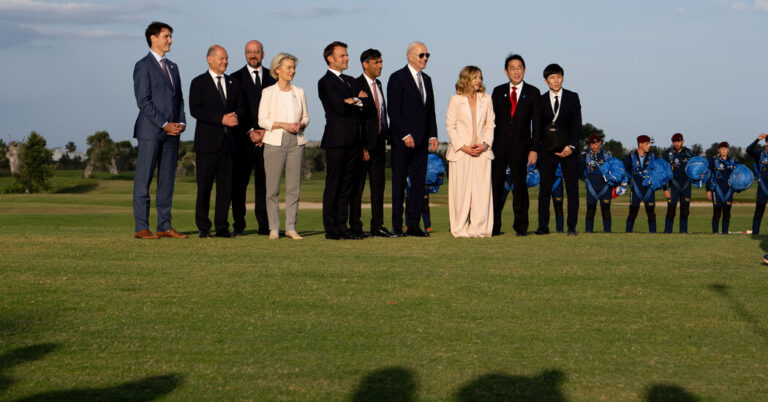The United States and other major Group of Seven economies agreed Thursday on a plan to give Ukraine a $50 billion loan to help it buy weapons and begin rebuilding damaged infrastructure. The move comes at a crucial moment in the war, when Russia has the momentum on the battlefield.
The details aren’t fully worked out yet, but that’s what we know.
Where will the money come from?
Initial money for the loan will come from the United States, the European Union and other G7 countries, although details of each entity’s contribution are still being worked out.
The idea is to use the nearly $300 billion in Russian assets in the West, frozen after Moscow’s invasion of Ukraine in February 2022, as the basis for the loan. This money will be repaid over time through profits from these Russian assets, around two-thirds of which are in Europe.
Most of the assets consist of matured bonds, earning interest, depending on the interest rate, of $3 billion to $4 billion per year.
Rather than simply providing Ukraine with this annual sum, which is relatively small given the demands of war, the G7 countries agreed on a loan, which could be provided to Ukraine by end of the year.
Ukraine’s current financial and military needs are estimated at around $100 million per year.
Which countries will contribute?
The G7 countries agreed at leadership level to provide the money needed for the loan.
The Americans said they would contribute the entire amount, but would like others to participate. A senior EU official, who requested anonymity to discuss the closed-door financial deliberations, said Friday morning that it was all still a matter of discussion but that for now the European Union was prepared to provide half, or about $25 billion, for $30 billion, the rest being financed by the Americans and others. The money would come from the European Union’s financial aid budget.
Leaders of EU states will have to approve any commitments from the bloc, the official said.
Since most of the assets are in Europe, Europeans want to ensure that when the revenue is spent, European companies will receive a fair share, especially European arms manufacturers.
Britain, Canada and Japan, all G7 countries, have also said they are ready to participate.
Ukraine will benefit from the profits from Russian assets and will not be responsible for repaying the loan.
What happens if interest rates fall?
One of the key questions is who will take responsibility for the loan if interest rates fall or a peace deal is suddenly reached that unlocks Russian assets.
It seems unlikely that these assets will be unfrozen, since the G7 previously agreed that they would be used to finance Ukraine’s post-war reconstruction. Given that the amount of money that will be needed to rebuild the country is at least twice the frozen assets and growing as the war continues, it is unlikely that Russia will ever recover these assets.
However, the question of who will guarantee the loan remains vague: responsibility should be shared between the countries that grant it, according to two European officials close to the negotiations.
What will the money be used for?
The loan will be made to Ukraine in different disbursements by the end of the year and will be aimed at three main purposes, the officials said: supporting Ukraine militarily, including helping it establish factories of armament on its territory; help cover the country’s budget deficit; and to help with the urgent reconstruction of infrastructure.
The disbursement is expected to depend in part on Ukraine’s ability to use the money wisely.
But how that amount will be paid and by which agencies is still under discussion, officials said. The World Bank is a possibility, they say. Nigel Gould-Davies, a senior fellow at the International Institute for Strategic Studies who has studied the issue, said another question was whether Ukraine would decide how to use the money itself. “Or, as he said, will this be decided for Ukraine?
“There are a lot of details we don’t know yet,” Mr Gould-Davies said, stressing that he would have preferred a direct seizure of assets, which would have been simpler. But some countries and central bankers, including Christine Lagarde, director of the European Central Bank, have ruled out this approach for now because it would have set a dangerous precedent.
Mr Gould-Davies said the current plan was “sub-optimal compared to a full seizure”.
“It’s more complicated and requires elaborate financial engineering that a foreclosure would not require,” he added.
But, he acknowledged, “given where we were a few days ago, this result is at the upper end of expectations. »
Ursula von der Leyen, president of the European Commission, the European Union’s executive body, said the deal was “a very strong message to Putin: Putin cannot outlast us, and we will stand by of Ukraine for as long as it takes.
In a nod to Europeans already worried about the cost of war, she added: “It is not European taxpayers who pay for Russian damage, but Russia. »


